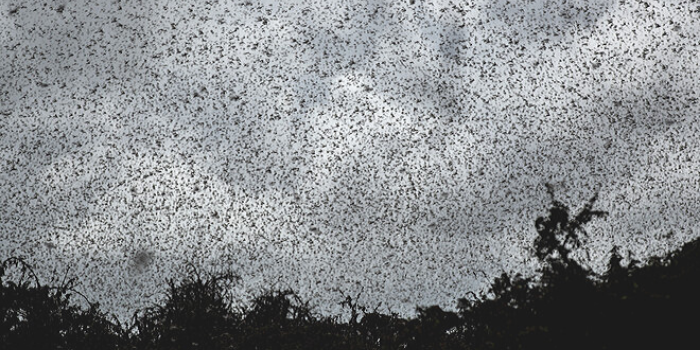
First Coronavirus, Now a Plague of Locusts!? How Can This Affect The US Economy
If you remember your Old Testament stories from Sunday School, you are probably familiar with the 10 plagues. In the book of Exodus, the bible tells the story of 10 Plagues of Egypt that God sent to Pharaoh and the Egyptians to free His people from slavery. The plagues, in order, are water to blood, frogs, lice/gnats, swarm of flies, pestilence of livestock, boils, thunderstorms of hail and fire, swarms of locusts, darkness for 3 days, and finally, death of the firstborn.
This is a powerful biblical story about the type of fury God can reign down to protect the people who believe in Him and punish the people who do not. Like many stories in the bible, scholars and theologians have long argued about how much of these stories are literal versus being parables to help teach the word of God. This particular story has long seemed more of just that, a story, than an actual recounting of events.
The reason that many think that the Plagues of Egypt is more allegory than fact is that the Plagues are things we have never seen before. Things like water turning to blood, thunderstorms of fire, and 72-hours of darkness are simply things that have not been seen on earth since this story. However, something is going on in 2020 that is not only scary but makes this story feel much closer to reality.
A Plague of Locusts, Happening Now
There is currently a wide swath of the world that is experiencing plagues of locusts, unlike anything they have seen in generations, if ever. Starting just southeast of where these bible stories originally took place in Egypt, there is a band of locust swarms affecting several countries right now. The band starts in northeast Africa in countries like Kenya, Uganda, Ethiopia, and Somalia. It continues northeast up through Yemen, Saudi Arabia, Qatar, and other Middle Eastern countries and then due east to India and Pakistan.
Researchers at the United Nations believe that this plague goes back to the 2018-19 cyclone season. During this season, there were torrential rains in the Arabian peninsula that were much greater than usual. This led to locusts breeding at an astonishing rate and developing an overpowering population that started to swarm and spread up to South Asia and down into Northern Africa.
In addition to this being a biblically terrifying situation, there are other issues these swarms of locusts present in these regions. Most importantly, these locusts are incredibly damaging to crops and other agriculture in the area. A swarm can easily wipe out an entire harvest in relatively short order. What makes this problem even bigger is there are only a few options to rid an area of this plague and none of them are very good.
Attempts to Eradicate Locust Swarms
How many locusts are we talking about? In a single swarm of locusts in Africa, it was estimated there were between 100 and 200 BILLION locusts.
The quickest and most effective way to kill massive amounts of locusts and stop them from invading an area’s crops is to use chemical pesticides. While these chemicals will do the job, they can ultimately be just as harmful, if not more so, to the crops they are being sprayed on and the end-consumer of those foods. This spraying of pesticides is currently going on in both Africa and Pakistan.
Another way to take care of this issue is with more eco-friendly biopesticides. These are pesticides made from natural materials – in this case, Metarhizium fungus – that kills the locusts but is much less harmful to the crops and humans than chemical pesticides. The problem with this is that it is much more expensive to make and more difficult to make enough quantity fast enough to do the full job. Somalia is one country experimenting with this.
Finally, there are locusts’ natural predators who can come in to do the job. Chickens can eat 70 locusts a day and ducks are even better, eating over 200 a day. According to a BBC report, China may be sending an army of 100,000 ducks to help Pakistan eradicate swarms of crop-eating locusts. While this is a great, natural way to kill locusts, the math just doesn’t work. In other words, you’d need a lot more ducks!
The Threat to the US Food Supply
Is there a threat to the US food supply? America has been locust swarm free since the turn of the 20th century. While the North American variety of locusts, the Rocky Mountain locust was a common problem in the late 1800s, they were eradicated and have now been extinct since 1902.
With all that is going on in Africa, the Middle East, and Asia right now with locusts though, it is more likely to come back than ever. To see just how this plague could spread, you do not need to look any further than what is currently going on with the coronavirus.
The coronavirus (COVID-19) started in Wuhan, China but quickly spread around the world. How did this happen? It happened because our world is more interconnected than ever and once someone with the virus traveled out of Wuhan, conditions were ripe for the virus to spread to other places.
Similar to coronavirus, some alarmists would argue that the same is true for these locusts. Global travel and trade are more common than ever and with port and border security being focused more on immigration than trade, the chances of a few stray locusts getting into the U.S. is a real possibility. Once this happens, the conditions are perfect for a large amount of breeding to take place, just like it did in the Middle East.
With the way the climate is changing, there is more rain, hurricanes, and flooding in places where this was not common than ever before. If locusts get into the American heartland and meet these conditions that encourage breeding, it’s reasonable to think that there will be nothing to stop massive swarms from devastating American crops.
The Potential Damage to the US Economy
Another lesson we can take from the coronavirus and apply to the possibility of US locust swarms is how vulnerable and volatile the US economy is right now. The threat of even a mild pandemic like coronavirus has sent shockwaves through the stock market and the impact on the real economy is sure to follow.
If swarms of locusts hit the heartland, it would devastate an entire year or more of crops for individual and industrial farmers alike. It would also annihilate grazing pastures which would be devastating for the US beef industry. If the swarms were bad enough, it could damage the USfood supply to the point where the country could not feed itself and would become totally reliant on other countries for food. This would have a crushing effect on the economy.
Look, put this into a reasonable perspective. Chances are that you’ll be hearing alarmist messages from other precious metals pundits. Let’s take it for what it is. The locust swarms are happening. The possibility of reaching the US is probably low. We don’t know, really. But the fact that it can expose the weaknesses of the US economy is likely--but again, we already know that, even before the coronavirus epidemic.
Whatever the outcome--regarding coronavirus or anything else that may stress the US and the global economy--it’s always best to diversify your assets (stocks, bonds, cash, and precious metals) and to keep your portfolio segments hedged against one another. After all, that’s the point of diversification, isn’t it?











